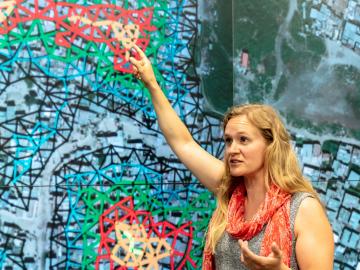
Filter News
Area of Research
- (-) Biology and Environment (21)
- (-) National Security (13)
- (-) Neutron Science (9)
- Computational Biology (1)
- Electricity and Smart Grid (1)
- Energy Science (31)
- Fusion and Fission (18)
- Fusion Energy (4)
- Isotopes (17)
- Materials (25)
- Materials for Computing (1)
- Nuclear Science and Technology (17)
- Quantum information Science (2)
- Supercomputing (17)
News Topics
- (-) Clean Water (10)
- (-) Coronavirus (10)
- (-) Cybersecurity (8)
- (-) Grid (3)
- (-) Microscopy (8)
- (-) Nuclear Energy (3)
- (-) Space Exploration (1)
- 3-D Printing/Advanced Manufacturing (5)
- Artificial Intelligence (14)
- Big Data (11)
- Bioenergy (30)
- Biology (47)
- Biomedical (17)
- Biotechnology (7)
- Buildings (1)
- Chemical Sciences (6)
- Composites (1)
- Computer Science (24)
- Energy Storage (4)
- Environment (62)
- Exascale Computing (4)
- Fossil Energy (1)
- Frontier (3)
- High-Performance Computing (16)
- Hydropower (6)
- Machine Learning (14)
- Materials (7)
- Materials Science (10)
- Mathematics (3)
- Mercury (6)
- Nanotechnology (5)
- National Security (24)
- Neutron Science (54)
- Partnerships (2)
- Physics (2)
- Polymers (2)
- Quantum Computing (1)
- Quantum Science (2)
- Security (6)
- Simulation (9)
- Summit (8)
- Transportation (1)
Media Contacts

Though Nell Barber wasn’t sure what her future held after graduating with a bachelor’s degree in psychology, she now uses her interest in human behavior to design systems that leverage machine learning algorithms to identify faces in a crowd.

To optimize biomaterials for reliable, cost-effective paper production, building construction, and biofuel development, researchers often study the structure of plant cells using techniques such as freezing plant samples or placing them in a vacuum.

How an Alvin M. Weinberg Fellow is increasing security for critical infrastructure components

Jennifer Morrell-Falvey’s interest in visualizing the science behind natural processes was what drew her to ORNL in what she expected to be a short stint some 18 years ago.

Unequal access to modern infrastructure is a feature of growing cities, according to a study published this week in the Proceedings of the National Academy of Sciences

Spanning no less than three disciplines, Marie Kurz’s title — hydrogeochemist — already gives you a sense of the collaborative, interdisciplinary nature of her research at ORNL.

A team led by ORNL and the University of Michigan have discovered that certain bacteria can steal an essential compound from other microbes to break down methane and toxic methylmercury in the environment.

Anyone familiar with ORNL knows it’s a hub for world-class science. The nearly 33,000-acre space surrounding the lab is less known, but also unique.

Moving to landlocked Tennessee isn’t an obvious choice for most scientists with new doctorate degrees in coastal oceanography.

An ORNL-led team comprising researchers from multiple DOE national laboratories is using artificial intelligence and computational screening techniques – in combination with experimental validation – to identify and design five promising drug therapy approaches to target the SARS-CoV-2 virus.


